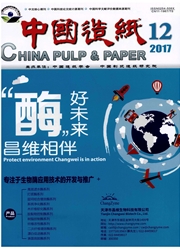

 中文摘要:
中文摘要:
通过胶黏物模拟物研究了黏性物质所构成体系的物理化学性质,讨论了外界条件对黏性物质稳定性和沉积行为的影响。研究结果表明,Na+、ca2+和Al3+等金属离子的存在,可以导致胶黏物模拟物的失稳。其中,Al3+在较低浓度即可引起胶黏物模拟物的絮聚,ca2+亦能使胶黏物模拟物产生沉积。阳离子聚合物的引入也是导致胶黏物模拟物失稳而沉积的重要原因,聚乙烯亚胺(PEU用量达到等电荷点时可使胶黏物模拟物发生完全失稳,少量阳离子聚丙烯酰胺(CPAM)即可以使胶黏物模拟物发生失稳。过量的PEI能使胶黏物模拟物微粒重新稳定,过量的CPAM却未能使胶黏物模拟物重新稳定。在浆水构成的体系中,加入阳离子聚合物可以使部分胶黏物模拟物吸附于纸浆纤维,表现为沉积量的降低。填料在用量较少时可与胶黏物模拟物一起沉积出来,用量多时则包裹了胶黏物模拟物微粒而减少了其沉积。
 英文摘要:
英文摘要:
Using model sticky substances consisted of the components of wood extractives and synthetic polymers, the effects of metal ions, cationic polymers and mineral fillers on the physicochemical properties and depositional behavior of sticky substances were investigated. Results showed that introducing A13 + into the system, even at a low concentration, can markedly destabilize sticky substances, and a similar behavior is observed for Ca2+. Cationic polymers affect significantly the stability of sticky substances. Polyethylene imine (PEI) results in destabilization at the neutral point, and lead to maximum deposition of stickies. Cationic polyacrylamide (CPAM) accelerates the aggregation of sticky particles even at a low dosage. Sticky particles may regain the stabilization as adding excessive dosage of PEI, but it may not be the similar for adding CPAM. Less sticks deposition is observed, when the system contains pulp fibers, which may be attributed to the attachment of stickies onto the fibers. Fillers can adsorb the sticky substances at a low dosage. However, the whole surfaces of stickies may be covered by excess amount of fillers and results in a less deposition.
 同期刊论文项目
同期刊论文项目
 同项目期刊论文
同项目期刊论文
 Changes of anionic groups in alkaline peroxide-impregnated aspen chemithermomechanical pulp during s
Changes of anionic groups in alkaline peroxide-impregnated aspen chemithermomechanical pulp during s Fiber surface characterization of old newsprint pulp deinked by combining hemicellulase with laccase
Fiber surface characterization of old newsprint pulp deinked by combining hemicellulase with laccase Location and fate of carboxyl groups in aspen alkaline peroxide-impregnated chemithermomechanical pu
Location and fate of carboxyl groups in aspen alkaline peroxide-impregnated chemithermomechanical pu 期刊信息
期刊信息
